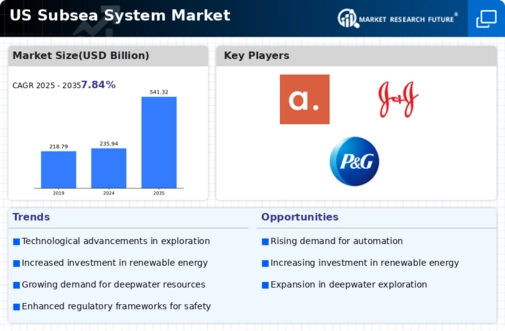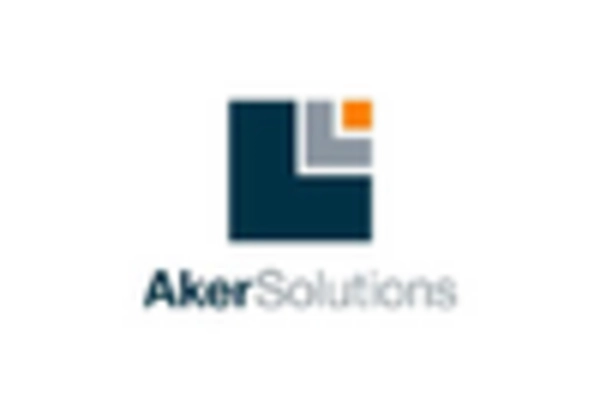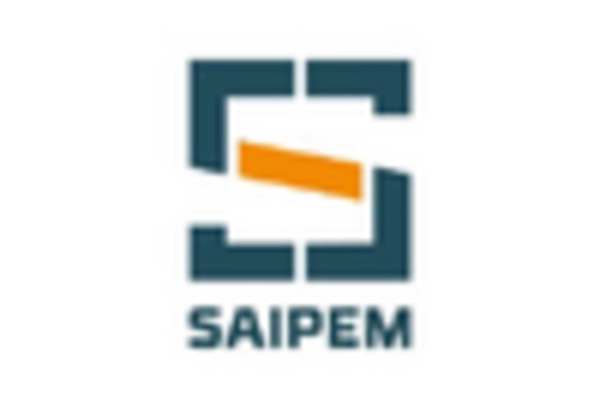Increasing Energy Demand
The subsea system market is experiencing a surge in demand driven by the increasing need for energy. As the US continues to rely heavily on fossil fuels, the exploration and extraction of oil and gas from subsea environments become critical. The Energy Information Administration (EIA) projects that US energy consumption will rise by approximately 10% by 2030. This growing demand necessitates advanced subsea systems to enhance extraction efficiency and safety. Furthermore, the transition towards renewable energy sources, such as offshore wind farms, is also contributing to the expansion of the subsea system market. The integration of subsea technologies in these projects is essential for optimizing energy production and minimizing environmental impact.
Technological Innovations
Technological innovations are a key driver in the subsea system market, as advancements in robotics, automation, and data analytics are transforming operations. The integration of autonomous underwater vehicles (AUVs) and remotely operated vehicles (ROVs) is enhancing the efficiency of subsea inspections and maintenance. The market for subsea robotics is anticipated to grow at a CAGR of 15% through 2027, reflecting the increasing reliance on these technologies. Moreover, the adoption of digital twin technology allows for real-time monitoring and predictive maintenance, reducing operational costs and downtime. These innovations not only improve safety but also enable companies to optimize their subsea operations, thereby driving market growth.
Regulatory Support and Policies
The subsea system market is influenced by regulatory support and policies aimed at promoting offshore energy development. The US government has implemented various initiatives to streamline permitting processes and encourage investment in subsea projects. For instance, the Bureau of Safety and Environmental Enforcement (BSEE) has introduced regulations that facilitate the safe and efficient operation of subsea systems. These policies are designed to enhance environmental protection while ensuring energy security. As a result, the subsea system market is likely to see increased activity, with more companies willing to invest in new technologies and infrastructure. This supportive regulatory environment is crucial for the long-term sustainability of the subsea sector.
Investment in Offshore Infrastructure
The subsea system market is benefiting from substantial investments in offshore infrastructure. The US government and private sector are increasingly allocating funds to develop and upgrade subsea facilities, which are vital for the extraction and transportation of hydrocarbons. According to the Bureau of Ocean Energy Management (BOEM), investments in offshore oil and gas infrastructure are projected to exceed $200 billion over the next decade. This influx of capital is likely to drive innovation and enhance the capabilities of subsea systems, making them more efficient and reliable. Additionally, the expansion of subsea infrastructure is expected to create numerous job opportunities, further stimulating the economy.
Growing Focus on Environmental Sustainability
The subsea system market is increasingly aligning with environmental sustainability goals. As public awareness of climate change rises, there is a growing demand for cleaner energy solutions. The US is witnessing a shift towards sustainable practices in offshore operations, with companies investing in technologies that minimize environmental impact. For example, the development of subsea carbon capture and storage systems is gaining traction, as it offers a viable solution for reducing greenhouse gas emissions. Furthermore, the integration of eco-friendly materials in subsea system design is becoming more prevalent. This focus on sustainability not only enhances the market's reputation but also attracts investment from environmentally conscious stakeholders.

















Leave a Comment